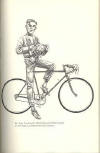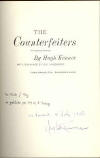| |
|
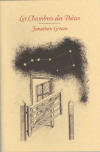 |
|
| |
|
"Foreword" in Jonathan Greene, Les
Chambres des Poètes. With Drawings by John Furnival & Foreword by Guy
Davenport, (Asheville, NC: French Broad Press, Distributed by the Captain's Bookshelf,
Asheville, NC, 1990), unpaged.
Includes the poem,
The Labor
for Guy Davenport
Nothing more beautiful,
for instance,
can be imagined than an iron club
carefully wound round with strips
of metal, the handle covered with
snake skin.
Frobenius
What focuses in the
attention
gleams with a light
hard for others to see.
|
| |
|
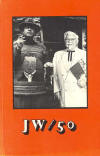 |
|
| |
"For Cousin
Jonathan On His Birthday" [poem] in Jonathan Greene, ed., A
50th
Birthday Celebration For Jonathan Williams. Gathered by Thomas A.
Clark, David Wilk, & Jonathan Greene. Edited [with 'Preface'] by Jonathan
Greene. Frankfort, KY: Truck / Gnomon, 1979. Unpaged (60 leaves, 4
of which are b&w photographs).
- Cover title: JW / 50
- At head of title page: Truck 21
- "This issue of Truck was
produced in a limited edition of 750 copies for subscribers to Truck
magazine & will be on sale at Books & Co. in New York in conjunction
with an exhibition of JW's and Jargon Society books on March 15, 1979.
It is also being issued as a book by Gnomon Press . . . Frankfort,
KY." (verso t-p)
- Front Cover Photograph: the Two
Colonels (the famous one has on his Astrid Furnival Samuel Palmer
sweater) -- Photograph by Joseph Anderson, Corn Close, 1974"
GD's poem celebrates his 'cousin' who
* * *
Is that Jonathan as in the friend of
the psalmist
Apollo questioned or as in Swift
Both O Lord of Light made Orpheus his answer
And his words chime with many kinds of
music
In the garden of poets he is a thistle
A sunflower a jonquil and a John Ruskin rose
* * *
Note: I attended the event at the
Books & Co. bookstore on Madison Avenue in New York, March 1979. The
place was packed, upstairs and down. My copy of JW / 50 is inscribed "JW,
Col". After the celebration I went downtown to the Village Vanguard. I
think Bill Evans was playing that evening with Joe Labarbera, drums and
Marc Johnson, bass).
|
| |
|
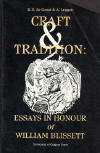 |
|
| |
"Stanley Spencer and David Jones" in H. B.
de Groot and Alexander Leggatt, eds.,
Craft and Tradition: Essays in Honour of
William Blissett. Calgary (Alberta) Canada:
University of Calgary Press, 1990. 334 pp. GD's essay, pp. 259-268.
Essay was reprinted in The Hunter
Gracchus (1996)
|
| |
|
 |
|
| |
"Foreword" in Daniel Haberman, The
Lug
of Days to Come: New and Selected Poems and Translations. Foreword by Guy
Davenport. Etchings by Jan Stussy.
Santa Barbara, CA: John Daniel and Company, 1996, pp.
11-13.
John Daniel and Company
[is] A Division of Daniel and Daniel, Publishers, Inc.
Excerpt:
"[Haberman's] editions of Shakespeare
that he designed and chose illustrators for, each play having its own
volume, boxed and bound with taste and restraint, are masterpieces of
the printer's art. These wide-margined, large square-paged, generously
spaced books, boldly naked of prefaces and notes, were given away
annually by the printing firm where Daniel worked as a typographer and
designer. I know of no other printing of Shakespeare that pays him
such honor, or emphasizes so beautifully the integrity and uniqueness
of each of the plays.
The public, however,
knows Daniel Haberman as the poet in residence at the Cathedral of St.
John the Devine, where he instituted the American Poet's Corner and
served as chairman of the board of electors who choose two poets every
year in a ceremony of readings and encomiums which have increasingly
become events attracting national attention. Daniel found a space for
American poetry to be honored and celebrated , and as with his
Shakespeare, by means of fine lettering and exact boundaries, using
two storehouses of the spirit, the book-shelf and a cathedral." (p
11)
Other Haberman books:
- Poems
(1977)
- The Furtive
Wall (1982)
. |
| |
|
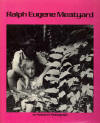 |
|
| |
|
"Reminiscence" in James Baker Hall, ed.,
Ralph
Eugene Meatyard, (Millerton, NY: Aperture, 1974), pp. 127-131. "An Aperture
Monograph"
Note: Gene Meatyard and his family lived in
Lexington, Kentucky on Kingsway Drive, which was the next street over from
Queensway Drive where my father and his family lived upon our return from
Orleans, France summer 1965. My younger brother, Jim, became
acquainted with Chris Meatyard, Gene's son, at school and over our backyard
fence. I did not learn of Gene Meatyard, however, until 1967 when I
first took a GD course at UK. From this reminiscence we discover that GD, soon
after he moved to Lexington circa 1963, learned of Gene Meatyard in a letter from
Jonathan Williams.
|
| |
|
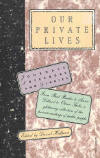 |
|
| |
"Journal" in Daniel Halpern, ed.,
Our
Private Eyes: Journals, Notebooks, and Diaries. (New York:
Vintage Books; A Division of Random House, 1990), pp. 76-83. "First
Vintage Books Edition, January 1990""
Published under the
title Journals, Notebooks, and Diaries. by The Ecco Press, New
York, in 1988." (verso t-p)
Originally published in Antaeus 61
(Autumn 1988) pp. 76-83. This issue is subtitled, Journals,
Notebooks & Diaries. Anteus published by The Ecco Press
Excerpts:
Protagoras sold
firewood. Demokritos liked the way he bundled it for carrying, and
hired him to be his secretary. Mind is evident in the patterns it
makes. Inner, outer. To discern these patterns is to be a philosopher.
The caterpillar of
the coddling moth feeds on the kernels of apples and pears.
Greek time is in the
eye, anxious about transitions (beard, loss of boyish beauty). Hebrew
time is in the ear (Hear, O Israel!). what the Greek gods say does not
make a body of quotations; they give no laws, no wisdom. But what they
look like is of great and constant importance. Yahweh , invisible, is
utterly different.
The American
automobile is his body.
* * *
Gibbon turns an idea
in his fingers.
French regularity is
kept alive as a spirit by turbulence and variation. Only a felt
classicism knows novelty. Novelty in the USA is a wheel spinning in
futility; it has no tangential ground to touch down and roll upon.
Je ne veux pas
mourir idiot. French student demanding the Greek be put back
into the curriculum.
* * *
What got Kipling a
bad name among Liberals is his intelligence, humor, and affection.
These they cannot tolerate in anybody.
Sartre's idea of
literature, the opposite of Pound's, is still within the category that
includes Pound. The word 'political' has a wholly different meaning in
the USA than in France. Our politicians have no interest whatever in
changing society, or of making life more liberal. How can they, with a
people who have to be sat on, and with criminal exploitation ready to
corrupt any liberal exploration of liberty? There is no reversal
possible of American mediocrity, which will worsen until we have total
depravity of the idea of freedom. There is no American business; only
diddling the consumer. The Congress is as incompetent and
irresponsible a squanderer of our money as the most loutish tyrant in
history.
* * *
I buy a blue denim
cap, very Danish student of the last century, and call it my Nietzsche
cap, remembering that he ordered a Danish student's uniform when he
learned that Georg Brandes was lecturing on him at the university
here. Bonnie Jean counters by buying a Lutheran house-wife's dress,
demure, practical, and quite becoming.
The restaurants on
Nyhavn are run by children. The cook at The mary Rose, Ejnar, looks
twelve, and the waiters are teenagers.
A profoundly
northern feel to the graveyard where Kierkegaard and Hans
Christian Andersen lie. Pale sunlight, wet conifers.
* * *
Rietveld's chair at
the Louisiana Museet. It is much smaller than I'd thought, and looks
comfortable.
Years ago I wrote in
Tatlin! that the Baltic is pewter and silver in its lakes of
glare. It is.
* * *
Where it was, there
must you begin to be. There are no depths, only distances. Memory
shuffles, scans, forages. Freud's geological model implies that last
year is deeper in memory than last week, which we all know to be
untrue. The memories we value are those we have given the qualities of
dream and narrative, and which we may have invented.
* * *
Desire is attention,
not gratification of the self. The ego is the enemy of love. Happiness
is always a return. It must have been out of itself to be anything at
all.
* * *
The hope of
philosophy was to create a tranquility so stable that the world could
not assail it. This stability will always turn out to be a madness or
obsession or brutal indifference to the world. Philosophy is rather
the self-mastery that frees one enough of laziness, selfishness, rage,
jealousy, and such failures of spirit, to help others, write for
others, draw for others, be friends.
* * *
Psychology is the
policeman of the bourgeoisie, enforcing middle-class values with as
bogus a science as alchemy or palm-reading. Foucault was right on this
point.
In Kafka other people
are too close and God is too far off.
|
| |
|
 |
|
| |
"Keeping Time"
in Daniel Halpern, ed., Who's Writing This? Notations
on the Authorial I with Self-Portraits. (Hopewell, NJ: The
Ecco Press, 1995), pp. [53]-55. Davenport drawing (self portrait) at p
[53]
Essay was published originally in Antaeus
73/74 (Spring 1994) pp. 19 - 20,
with a self-portrait drawing of GD on p. [18].
Essay is included in The
Hunter Gracchus (1996) at pp. 318-319.
Essay begins:
"Borges y Yo . * * *
and ends:
"My daimon likes to say that only I can
write my stories, and has refused to have anything to do with this
miniature essay on 'the authorial I.' It has no weather in it, no
apples in a silver bowl, no goats with oblong eyes. Taedium
taurique stercus, he says. So I have had to write this all by
myself."
|
| |
|
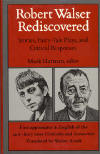 |
|
| |
[Drawings] in Mark Harman, ed.,
Robert Walser
Rediscovered: Stories, Fairy-Tale Plays, and Critical Responses. Including the
Anti-fairy tales Cinderella and Snowwhite. Translated by Walter Arndt. Hanover, NH:
Published for Dartmouth College by University Press of New England, 1985.
"The two drawings of
Robert Walser by Guy Davenport are reprinted here by permission of the
artist and The Georgia Review, copyright 1977 by the University
of Georgia." ('Acknowledgments' p. 219)
Note: The two drawings
appear separately only on the front of the book's dust jacket. A
composite drawing of the young and older Walser serves as frontispiece
with the caption, "Drawings by Guy Davenport".
The two drawings of
Robert Walser, young man and old, were published as integral parts of
"A Field of Snow on a Slope of the Rosenberg"
Georgia Review 31:1 (Spring 1977) pp. 5-41.
This story was reprinted in Da Vinci's Bicycle.
GD is cited (p. 216)
under heading "Robert Walser as a Fictional Figure" for his story, "A
Field of Snow on a Slope of the Rosenberg" In Da Vinci's Bicycle,
pp. 149-185. Baltimore: The Johns Hopkins University Press, 1976 (sic,
in recté 1979).
The editor, Mark
Harman, refers also to Davenport in his 'Introduction: A Reluctant
Modern" (p. 11) in the following paragraph:
"Walser renounces the
transitions and 'epic connections' that irritate him in favor of an
art that relies on juxtapositions rather than transitions. William
James might be describing Walser's writings when he observes in 'The
World of Pure Experience' that 'experience itself, taken at large, can
grow by its edges.' If James expanded our conception of experience in
philosophy, thereby helping to usher in the modernist breakthrough in
English writing, Robert Walser accomplishes something similar in
literature. Perhaps that is why in Guy Davenport's story 'A Field of
Snow on a Slope of the Rosenberg,' William James pays a courtesy call
on Robert Walser in Biel."
|
| |
|
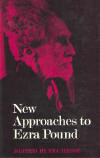 |
|
| |
"Persephone's Ezra," in Eva Hesse, ed.,
New
Approaches to Ezra Pound: A Co-ordinated Investigation of Pound's Poetry and Ideas,
Edited with an
introduction by Eva Hesse.
(Berkeley, CA: University of California Press, 1969), pp. 145-173.
"This collection
[copyright by] Faber & Faber Ltd 1969"
(verso t-p)
Essay was published first in Arion 7:2 (Summer
1968) 165-199.
|
|
|
|
|
|
|
|
|
"Frobenius auf Pounds Sextant" in Eva Hesse,
ed., Ezra Pound: 22 Versüche über einen Dichter, (Frankfurt am Main:
Athenäum Verlag, 1967), pp. 186-202.
"Ob Ezra Pound einen konfuzianischen Frieden gefunden
hat oder ob der Puma noch immer mit seinem Käfig hadert, ist schwer zu sagen ..."
Note: Professor Davenport loaned this book to
me so I could make a photocopy of his essay. The book along with my copy of
my Davenport checklist was in a green canvas 'Harvard' bag which I placed in
a storage bin at the entrance of a bookstore. After browsing the sale tables
I left to go to a nearby eatery, and when I went to the storage bin to
retrieve my bag, it was gone! Not only had I lost GD's book but also
my only copy of my checklist. (Fortunately, I did have 3-by-5 note cards as
a backup). I reported this incident immediately to GD, who fortunately had a
second copy of the book. This was Summer 1974
|
| |
|
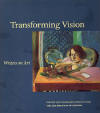 |
|
| |
| "On Grant Wood, ‘American Gothic’, 1930":
Excerpt from The Geography of the Imagination in
Transforming Vision: Writers
on Art. Selected and introduced by Edward Hirsch [of the] Art Institute of
Chicago. Boston, MA: Little, Brown; A Bullfinch Press Book, 1994, pp. 61-63. |
| |
|
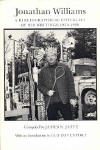 |
|
| |
| [Introduction] in James S. Jaffe, comp., Jonathan
Williams: A Bibliographical Checklist of His Writings, 1950 -- 1988. With an
Introduction by Guy Davenport, (Haverford, PA: James S. Jaffe Rare Books, 1989), pp.
vii-ix. |
| |
|
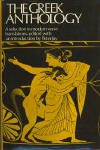 |
|
| |
|
[Translations] in Peter Jay, ed., The
Greek
Anthology and Other Ancient Greek Epigrams, (New York: Oxford, 1973),
passim.
From 'Notes on Contributors and Index to the Translations'
(p. 425):
Guy Davenport -- Poet and translator of Archilochos (Carmina
Archilochi, 1964) and Sappho (Sappho: Poems and Fragments, 1965). He
teaches English at the University of Kentucky, Lexington. [GD is
responsible for the following numbered entries:] 1, 2, 4, 742, 749,
756, 757, 823, 827, 828, 830, 856, 859.
- Archilochos: . . .1, 2, 4 . . . . . .
. . . . . . . . . . . . . . . . . . . . . . pp. 35-36
- Anon.: . . . . . . . . . 742 . . . .'Sthenelais'
. . . . . . . . . . . . . . . . p. 323
- Anon.: . . . . . . . . . 749 . . . .'A Gift'
. . . . . . . . . . . . . . . . . . . . p. 324
- Anon.: . . . . . . . . . 756 . . . .'To Priapos'
. . . . . . . . . . . . . . . . . p. 326
- Anon.: . . . . . . . . . 757 . . . .'To Astarte'
. . . . . . . . . . . . . . . . . p. 326
- Agathias: . . . . . . . 823 . . . .'Partridge'
. . . . . . . . . . . . . . . . . . p. 354
- Agathias: . . . . . . . 827 . . . .'A Bridge on the Sangarios'
. . . . . p. 355
- Agathias: . . . . . . . 828 . . . .'A Latrine in a Suburb of Smyrna'.
. p. 356
- Agathias: . . . . . . . 830 . . . .'The Astrologer'
. . . . . . . . . . . . . pp. 356-357
- Anon.: . . . . . . . . . 856 . . . .'Christ'
. . . . . . . . . . . . . . . . . . . . p. 369
- Anon.: . . . . . . . . . 859 . . . .'Nile the Hermit'
. . . . . . . . . . . . . p. [370]
Excerpt: (Agathias # 828)
A
Latrine in a Suburb of Smyrna
Here the savoury roast and pungent sauce
Have lost their beauty, changed to filth.
Pheasant, herb ground with the pestle, fish,
Ox-and-garlic hash, with pickled eels,
Are so much dung. In at the mouth,
Out from the belly! Silly enterprise,
To have spent gold for all this dirt.
|
| |
|
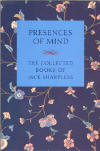 |
|
| |
[Afterword] in Ronald Johnson, ed.,
Presences of
Mind: The Collected Books of Jack Sharpless. With Afterwords by Guy
Davenport & Jonathan Williams,
(Frankfort, KY: Gnomon, 1989), pp. 103-105. |
| |
|
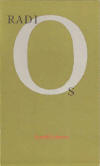 |
|
| |
|
"An Afterword" in Ronald Johnson,
Radi
os, (Berkeley, CA: Sand Dollar Books, 1977), unpaged.
Note: the space between the 'i' and the 'o' in the title is
intentional and is an allusion to Milton's epic poem PaRadise Lost.
|
|
|
|
|
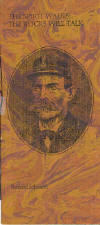
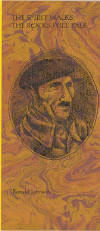
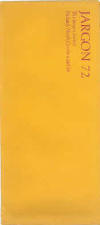 |
| |
|
[Drawings] in Ronald Johnson, The
Spirit Walks,
The Rocks Will Talk: Eccentric Translations From Two Eccentrics. With
Vignettes by Guy Davenport. (New York and Penland, NC: The Jargon Society, 1969), Jargon
72.
Two vignettes, one on each cover and repeated on title pages.
Enclosed in a goldenrod-colored, business-size envelope.
"500 copies of this opusculum have been printed in the
autumn of 1969 by Heritage printers, Charlotte, North Carolina, for distribution among
those friends of the Jargon Society who may be lacking their own private winter
garden" No. 76 signed by RJ and GD.
|
| |
|
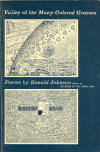 |
|
| |
| "Introduction" in Ronald Johnson,
Valley
of the Many-Colored Grasses, (New York: W.W. Norton, 1969), pp. 9-14. |
|
|
|
|
|
| |
|
"Yes, 'Trees' is Popular With The Rotarians. Yes,
It's Vulnerable. But, Then . . ." in Thomas S. Kane and Leonard J. Peters,
Writing
Prose: Techniques and Purposes. 5th edition. (New York: Oxford, 1980), pp.
518-523.
First published in the New York Times (January 28,
1978) 21.
|
| |
|
|
|
| |
|
"Doughty, Charles M., The Dawn in Britain"
in Linda Sternberg Katz and Bill Katz, eds.,
Writer's Choice: A Library of
Rediscoveries, (Reston, VA: Reston Publishing Co., A Prentice-Hall Co., 1983), pp.
161-162.
Note: GD has mentioned Doughty's epic poem The Dawn in
Britain (London: Duckworth, 1906) not a few times during conversations and lectures.
"It is, I believe, the only English epic ... I admire Doughty for his narrative
invention, his mightly line, his wholly original diction [a useful GD example is Doughty's
word 'sunprint' for today's 'photograph'), his nobility, his grandeur of heart -- the very
qualities in Homer which no translator since Chapman has got anywhere near ... His
masterpiece has always been taken to be the magnificent Travels in Arabia Deserta
(his Odyssey). The Dawn (his Iliad) must be put beside it ... Doughty is simply a
narrative poet whose concern is to make us see and feel a pattern in history: the
convergence of the people who buried a king in Sutton Hoo, built Stonehenge, and wrote The
Beowulf with some stray Romans and Syrians who had a drinking cup used by a rabbi who had
been crucified by Roman legionaries, which rabbi they believed to be God, who as a man had
brought a vision of mercy and brotherhood."
GD is quoted also in the entry, "Mandelstam, Nadezhda, Hope
Against Hope", p. 145.
|
| |
|
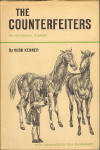 |
|
| |
|
[Drawings] in Hugh Kenner, The
Counterfeiters:
An Historical Comedy, with Drawings by Guy Davenport, (Bloomington, IN:
Indiana University Press, 1968).
Professor Davenport asked me to serve as a model for his
drawing of Alan Turing. I visited the Professor's apartment one fall morning
1967.
I straddled a bicycle with an alarm clock (upside down) strung about my neck. As I recall
that day, GD while talking about Turing, worked quickly sketching trouser folds and the
tilt of my head.
Afterward we sat in his living room, drank coffee, and smoked. I
can see the Professor reaching to his left for his lighter and Marlboros. The Fourth of
July 1968, I visited GD who had as his guest, Professor Hugh Kenner. GD gave me a
copy of this book with his inscription, "For Chuck / Guy -- In gratitude for 6/7 of
A. Turing". HK also inscribed his book: "Endorsed, 4 July
1968".
|
| |
|
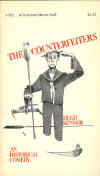 |
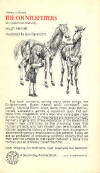 |
| |
|
[Drawings] in Hugh Kenner, The Counterfeiters:
An Historical Comedy. With drawings by Guy Davenport, (1968; reprint Garden
City, NY: Anchor Press, 1973).
Inscribed "Hugh Kenner Lexington Jan '75"
|
| |
|
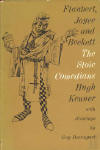 |
|
| |
|
[Drawings] in Hugh Kenner,
Flaubert, Joyce and
Beckett: The Stoic Comedians, with drawings by Guy Davenport, (Boston:
Beacon Press, 1962).
"The illustrations are intended to keep the reader from
dwelling on the paucity of documentation." ("Author's Note")
|
|
|
|
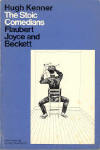 |
|
|
|
|
[Drawings] in Hugh Kenner, Flaubert, Joyce and
Beckett: The Stoic Comedians, (1962; reprint Berkeley, CA:
University of California Press, 1974) |
|
|
|
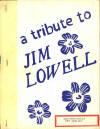 |
|
|
|
|
[Untitled Essay] in Tom Kryss, ed., A
Tribute to
Jim Lowell, (Cleveland, OH: Ghost Press, 1967), leaf 38 of 54 leaves.
"500 copies June 1967" |
|
|
|
|
| |
|
|
Back to Parts of
Books (All) |



















